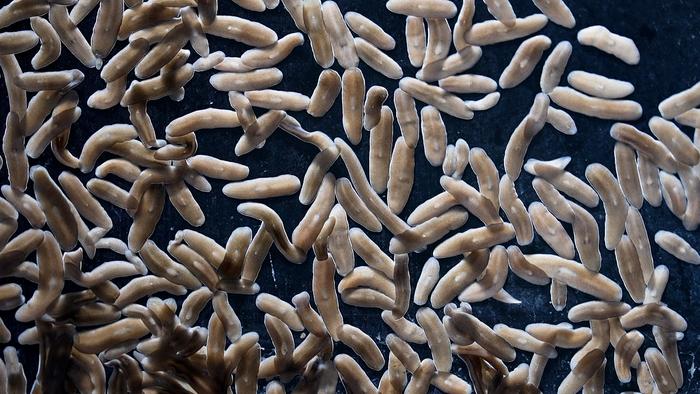![Planarian flatworms pictured in the Stowers Institute's planarian facility. A recent discovery from Stowers scientists may help explain the flatworm’s extraordinary ability to regenerate — and could offer clues for developing new ways to replace or repair tissues in humans. [Stowers Institute for Medical Research] Planarian flatworms pictured in the Stowers Institute's planarian facility. A recent discovery from Stowers scientists may help explain the flatworm’s extraordinary ability to regenerate — and could offer clues for developing new ways to replace or repair tissues in humans. [Stowers Institute for Medical Research]](https://www.genengnews.com/wp-content/uploads/2025/10/low-res-8-696x392.jpeg)
Stem cells in most organisms typically take cues from adjacent cells. But new research from the Stowers Institute for Medical Research has found that stem cells in the freshwater planarian Schmidtea mediterranea ignore their nearest neighbors and instead respond to signals further away in the body. The research challenges the textbook concept that most stem cells reside in a fixed, physical place called a niche, where surrounding cells tell them when or when not to divide and what to become. The discovery may help explain the flatworm’s extraordinary ability to regenerate—and could offer clues for developing new ways to replace or repair tissues in humans.
Led by postdoctoral research associate Frederick “Biff” Mann, PhD, from the lab of Stowers President and chief scientific officer Alejandro Sánchez Alvarado, PhD, the scientists reported on their findings in Cell Reports. Sánchez Alvarado said, “Understanding how stem cells are regulated in living organisms is one of the great challenges in the fields of stem cell biology and regenerative medicine. This finding challenges our concept of a stem cell ‘niche’ and may significantly advance our understanding of how to control stem cells’ abilities to restore damaged tissues.”
In their paper titled “Molecular and cellular characterization of planarian stem cell microenvironments,” the investigators reported “Our comprehensive analysis of planarian stem cell microenvironments using spatial transcriptomics, high-resolution imaging, and EM has revealed a complex and dynamic stem cell niche that expands our current concepts of stem cell regulation … investigating how a broad niche architecture contributes to the maintenance of stem cell pluripotency and the coordination of signals across the planarian body stands to provide valuable insights into the biology of regeneration.”
Stem cells are defined by their ability to self-renew and differentiate into other cell types, the authors wrote. “To balance these processes and avoid hyperproliferation or stem cell exhaustion, stem cell activity is regulated through local tissue microenvironments called niches.” Mann noted, “For instance, human blood-forming stem cells reside in niches within bone marrow where they divide to self-renew and make new blood cells.”
Adult planarian stem cells have unlimited potential to become any type of cell, in contrast to most other organisms including humans whose stem cells are tightly regulated to enable them to produce just a few specialized cell types. Part of this control system is in place to help prevent unchecked cell growth, which is a hallmark of cancer. But as the team noted, the mechanisms supporting stem cell function in highly regenerative organisms such as the planarian flatworm aren’t clear.
Through their newly reported research the team revealed that the planarian’s remarkable ability to regrow body parts, for example, rebuilding an amputated head or even an entire body from just a tiny fragment, is linked to stem cells that act more independently from their surroundings than those in most other animals. “Our hope is to uncover the basic rules that guide stem cells to become specific tissues as opposed to going rogue, as most tumors in humans begin when stem cells stop following these rules,” said Sánchez Alvarado.
Armed with the emerging technology of spatial transcriptomics, the researchers could determine which genes are turned on not just within one cell but also within surrounding cells in a tissue. This revealed surprising neighbors—notable varieties of cell types that surround stem cells. The most prominent was one not previously characterized—a very large cell with a multitude of projections, or fingerlike extensions of its cell membrane. The team named these cells “hecatonoblasts” after Hecatoncheires, a Greek mythological monster with many arms. “Because they were located so close to stem cells, we were surprised to find that hecatonoblasts were not controlling their fate nor function, which is counterintuitive to a typical stem cell-niche connection,” said Mann. The authors noted, “Surprisingly, while hecatonoblasts were in close physical proximity to stem cells in the mesenchyme, they were dispensable for regeneration.”
Instead, the team discovered the strongest instructions came from intestinal cells—the next most prominent cell type in their dataset. They found these cells were indeed providing planarian stem cells with instructions regarding their position and function during regeneration, despite being a considerable distance away. “In contrast, intestinal cells, despite lacking direct contact with stem cells, regulated both their position and function during regeneration,” the team stated. “Thus, while hecatonoblasts are dispensable, the intestine’s interaction with stem cells appears critical for regenerative success.”
Co-corresponding author Blair Benham-Pyle, PhD, an assistant professor at the Baylor College of Medicine in Houston, Texas, and former Stowers postdoctoral research associate, commented, “I tend to think about this as local versus global communication networks,” adding, “While interactions between stem cells and their neighboring cells influence how a stem cell reacts immediately, distant interactions may control how that same stem cell responds to big changes in an organism.”
The team discovered that planarian stem cells seem to be uncoupled from traditional contact-based niches and “found that there isn’t a specific cell type or factor right next to stem cells that is controlling their identity,” said Benham-Pyle. “The big discovery is a property of the whole planarian permitting both subtle local interactions and global signaling events that allow stem cells to achieve these remarkable feats of regeneration.” The researchers hypothesize that this may be the key underlying planarian stem cell potency, and the incredible regenerative feats flatworms can perform.
“The role of a traditional niche may be more in line with a micromanager—instructing cells, ‘You can be a stem cell, but only one particular type’,” added Mann. “However, we’ve now shown having a normal niche may not be essential for stem cells to work. Some stem cells, like those in the planarian flatworm, have figured out a way to be independent and can turn into any type of cell without needing a nearby niche.”
Sánchez Alvarado further commented, “The most surprising finding is that, at least in planarians, the environment in which the stem cells reside is not fixed. Instead, it’s dynamic—where stem cells reside is essentially made up by ‘friends’ that the stem cells and their progeny make along the way to differentiation. The more we understand how nearby cells and overall signals in the body work together to boost the ability and power of our stem cells, the better we’ll be at creating ways to improve the body’s natural healing. This knowledge could help develop new treatments and regenerative therapies for humans in the future.”
In their paper the team concluded, “Future research should focus on elucidating the specific molecular mechanisms underlying the distance-mediated regulation of stem cells by intestinal cells and other niche components … investigating how a broad niche architecture contributes to the maintenance of stem cell pluripotency and the coordination of signals across the planarian body stands to provide valuable insights into the biology of regeneration.”


